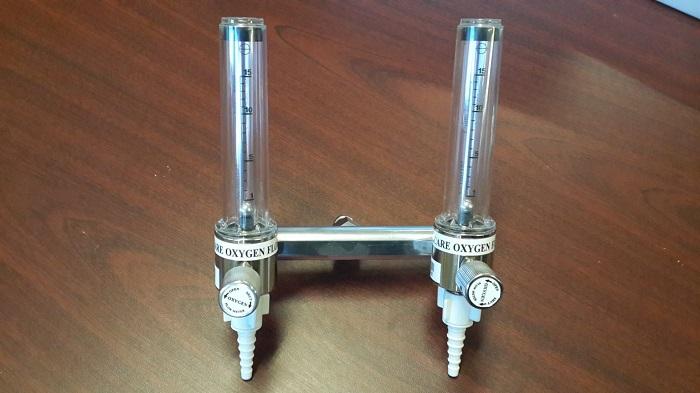Can an Oxygen Flow Meter Be Used with Concentrators?

Oxygen flow meters are essential devices used to measure and control the flow of oxygen to patients in medical settings. They ensure that the right amount of oxygen reaches the user, whether through masks, nasal cannulas, or other delivery systems. Oxygen concentrators are medical devices designed to extract oxygen from ambient air and provide a continuous supply to patients who need supplemental oxygen. A common question arises in both clinical and home care environments: can an oxygen flow meter be used with concentrators? This article explores this question, examining the functionality, compatibility, and best practices for using oxygen flow meters with concentrators.
Understanding Oxygen Flow Meters
Functionality of Oxygen Flow Meters
An oxygen flow meter measures the rate at which oxygen passes through a delivery system. It typically shows the flow in liters per minute and allows precise adjustments. This precision is critical in medical care because too much oxygen can lead to toxicity, and too little can worsen a patient’s condition. Oxygen flow meters come in different designs, including rotameter types, digital models, and integrated systems built into oxygen delivery devices.
Importance in Patient Care
Using an oxygen flow meter ensures that a patient receives oxygen at a safe and therapeutic rate. It is especially important for patients with chronic respiratory conditions like chronic obstructive pulmonary disease or during acute care situations such as post-surgery recovery. Accurate oxygen delivery prevents complications and helps maintain stable blood oxygen levels.
Understanding Oxygen Concentrators
How Oxygen Concentrators Work
Oxygen concentrators take in ambient air and remove nitrogen to provide a higher concentration of oxygen. They work continuously and can supply oxygen at varying flow rates, typically ranging from one to five liters per minute for portable units and higher for stationary units. Concentrators are commonly used at home and in medical facilities as a more convenient alternative to oxygen cylinders.
Types of Oxygen Concentrators
There are two main types of oxygen concentrators. The first type is stationary, designed for patients requiring high flow rates and continuous oxygen supply. The second type is portable, suitable for patients who need oxygen while moving or traveling. Both types deliver oxygen at a controlled rate, which is often adjustable through built-in flow regulators.
Compatibility of Oxygen Flow Meters with Concentrators
Using Flow Meters with Concentrators
Oxygen flow meters can be used with oxygen concentrators, but compatibility depends on the type of flow meter and concentrator. Most modern oxygen concentrators have integrated flow regulators, which act similarly to flow meters by allowing the user to adjust the oxygen output. Adding an external oxygen flow meter is generally possible but requires careful calibration to avoid over- or under-delivery of oxygen.
Precautions When Using Flow Meters
When attaching an oxygen flow meter to a concentrator, it is important to consider the pressure output of the device. Concentrators typically deliver oxygen at low pressure, and some flow meters may not function accurately if the pressure is below a certain threshold. Additionally, improper attachment can lead to leaks, reducing the efficiency of oxygen delivery and potentially compromising patient safety.
Benefits of Using Oxygen Flow Meters with Concentrators
Enhanced Accuracy
An oxygen flow meter can provide more precise readings than the built-in regulator of a concentrator. This is especially useful in clinical settings where exact oxygen flow is required. Accurate measurement ensures patients receive the correct oxygen dose for their medical condition.
Monitoring Oxygen Delivery
Flow meters allow healthcare providers to monitor oxygen delivery in real time. They help detect issues such as blockages, leaks, or equipment malfunction. Monitoring is critical for patients whose oxygen needs fluctuate throughout the day or night.
Flexibility in Adjustment
External flow meters offer more flexibility in adjusting oxygen flow. Some concentrators have limited settings, while a flow meter can fine-tune the oxygen delivery to meet specific therapeutic requirements. This adjustment can be crucial for patients with changing oxygen demands.
Limitations and Considerations
Device Calibration
To use an oxygen flow meter effectively with a concentrator, proper calibration is essential. An uncalibrated flow meter may display inaccurate readings, which could lead to incorrect oxygen delivery. Regular maintenance and calibration checks are necessary to maintain accuracy.
Flow Rate Restrictions
Some oxygen concentrators cannot support the full range of flow rates displayed on a separate flow meter. Exceeding the concentrator’s maximum output can damage the device or reduce its efficiency. Users must ensure that the selected flow rate is compatible with the concentrator’s capabilities.
Maintenance Requirements
Using an additional flow meter adds another component that requires maintenance. Both the concentrator and flow meter need regular cleaning and inspection to prevent contamination and ensure consistent oxygen delivery.
Best Practices for Safe Use
Professional Guidance
Always consult a healthcare provider before adding an oxygen flow meter to a concentrator. Medical professionals can determine the appropriate flow rate and ensure that the setup is safe for the patient’s needs.
Correct Installation
Proper installation is key. The flow meter must be securely attached to avoid leaks, and connections should be checked regularly. Users should follow manufacturer instructions for both the concentrator and flow meter.
Regular Monitoring
Even with an oxygen flow meter, continuous monitoring of oxygen levels is recommended. Pulse oximeters can help track blood oxygen saturation to ensure the patient receives the intended oxygen dose.
Conclusion
Oxygen flow meters can be used with oxygen concentrators, but users must consider compatibility, calibration, and pressure requirements. Flow meters provide more precise readings and flexible adjustment, which can enhance patient care. However, proper installation and regular monitoring are essential to ensure safe and effective oxygen delivery. When used correctly, an oxygen flow meter can complement a concentrator and improve the management of oxygen therapy in both home and clinical settings.
- Art
- Causes
- Crafts
- Dance
- Drinks
- Film
- Fitness
- Food
- Juegos
- Gardening
- Health
- Home
- Literature
- Music
- Networking
- Other
- Party
- Religion
- Shopping
- Sports
- Theater
- Wellness



